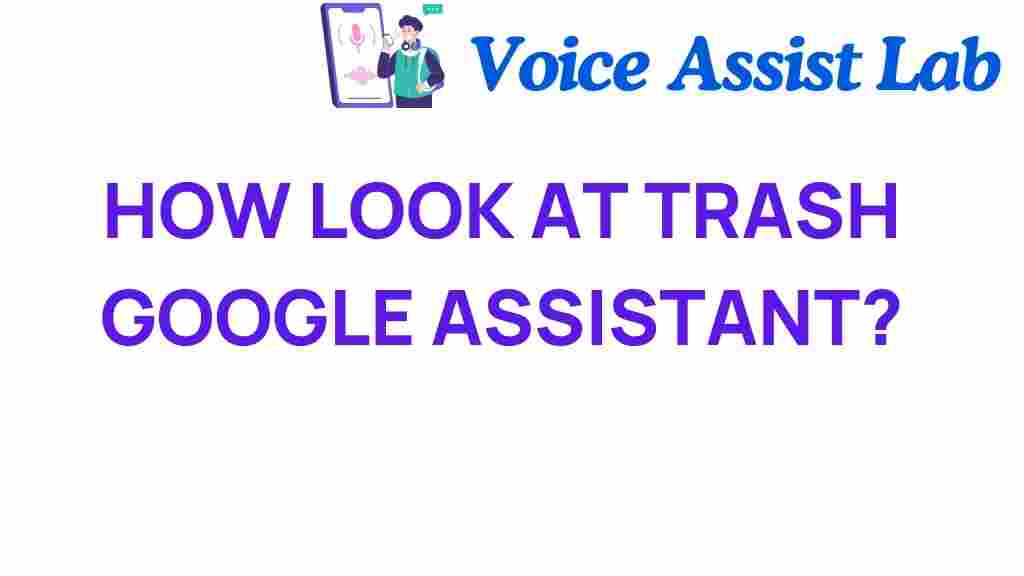Transforming Trash: How Google Assistant Can Revolutionize Waste Management
In the age of innovative technology, the need for sustainable waste management solutions has never been more pressing. As urban populations grow and environmental concerns rise, finding effective ways to manage trash is crucial. Enter Google Assistant, a powerful tool that can significantly enhance our approach to waste management, trash sorting, and recycling efforts. This article explores how Google Assistant can transform the way we handle waste, making it smarter, more efficient, and environmentally friendly.
Understanding the Importance of Waste Management
Waste management is not just about disposing of trash; it’s about creating a sustainable future. The environmental impact of poor waste practices can be devastating, leading to pollution, health hazards, and depletion of natural resources. By implementing smart solutions through technology, we can improve our waste management systems. Here are some key points to consider:
- Reduction of Landfill Waste: Efficient waste management minimizes what ends up in landfills.
- Recycling: Encouraging recycling helps conserve resources and reduces environmental impact.
- Community Engagement: Informed citizens are more likely to participate in sustainable practices.
How Google Assistant Can Enhance Waste Management
With its voice recognition and integration capabilities, Google Assistant can play a pivotal role in waste management. Here are some innovative ways it can help:
1. Trash Sorting Assistance
One of the most significant challenges in waste management is proper trash sorting. With Google Assistant, users can easily identify how to dispose of items correctly. For example:
- Voice Commands: Users can ask, “Hey Google, can I recycle this?” and receive instant guidance on whether an item is recyclable or should be discarded.
- Visual Recognition: Integrating visual recognition tools with Google Assistant can help users scan items for sorting instructions.
2. Recycling Reminders
Setting up reminders for recycling days can help communities improve their recycling rates. Google Assistant can:
- Schedule Alerts: Users can set up recurring reminders for when to put out recycling bins.
- Provide Tips: Daily tips on recycling can be delivered through voice commands or notifications.
3. Educational Resources
Google Assistant can serve as an educational tool, providing information on sustainability and recycling practices. Users can ask questions like:
- “What are the benefits of recycling?”
- “How can I reduce my waste?”
In response, Google Assistant can offer valuable insights and resources, guiding users toward more sustainable practices.
Step-by-Step Process for Implementing Google Assistant in Waste Management
Integrating Google Assistant into your waste management routine can be simple and effective. Follow these steps:
Step 1: Set Up Google Assistant
Ensure you have Google Assistant enabled on your device. This can be done via:
- Smartphones (Android and iOS)
- Smart speakers (Google Home, Nest)
Step 2: Customize Your Preferences
Personalize your Google Assistant experience by:
- Setting your location to receive local waste management updates.
- Connecting third-party apps that focus on recycling and sustainability.
Step 3: Engage with Voice Commands
Start using Google Assistant for waste management by trying out various voice commands. For example:
- “Hey Google, how do I recycle plastic bags?”
- “What day is my recycling pickup?”
Step 4: Share with Your Community
Encourage friends and family to use Google Assistant for waste management. Share tips and tricks on how it can help them make a difference.
Troubleshooting Tips for Using Google Assistant in Waste Management
While Google Assistant is a powerful tool, users may encounter some challenges. Here are some common issues and solutions:
Issue 1: Unresponsive Voice Commands
If Google Assistant does not respond to your commands:
- Check your internet connection.
- Ensure your device’s microphone is functioning properly.
Issue 2: Inaccurate Information
Sometimes, Google Assistant may not provide the correct answers. To mitigate this:
- Cross-check information with local waste management guidelines.
- Provide feedback to Google to improve its accuracy.
Issue 3: Limited Local Data
Google Assistant may not have information specific to your area. To overcome this:
- Visit local government websites for detailed waste management practices.
- Utilize community resources, such as local recycling centers.
The Environmental Impact of Smart Waste Management
By leveraging the capabilities of Google Assistant, we can significantly enhance our waste management systems. The environmental impact of adopting smart solutions is profound:
- Lower Carbon Footprint: Efficient waste management reduces greenhouse gas emissions.
- Resource Conservation: Increased recycling leads to less extraction of raw materials.
- Community Health: Proper waste disposal contributes to healthier living environments.
Embracing innovative technology like Google Assistant not only simplifies the process of waste management but also fosters a culture of sustainability.
Conclusion
In conclusion, the integration of Google Assistant into our waste management practices can lead to a significant transformation in how we handle trash. From improving trash sorting to providing valuable recycling reminders and education, the potential is vast. As we strive for sustainability and seek to minimize our environmental impact, adopting smart solutions through innovative technology is the way forward.
By embracing these advancements, we can all contribute to a cleaner, greener planet. For more information on waste management and sustainability, visit this resource and explore how you can make a difference today!
Ready to take the next step? Start using Google Assistant for your waste management needs and witness the transformation in your daily routine!
This article is in the category Innovations and created by VoiceAssistLab Team
